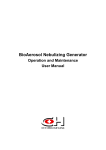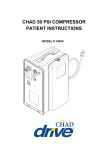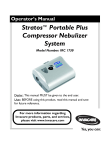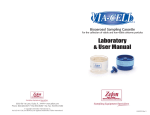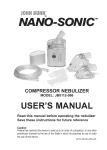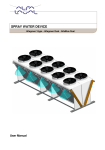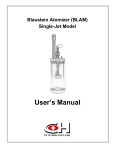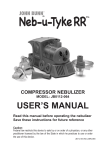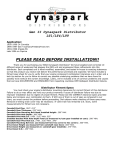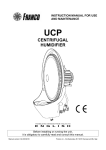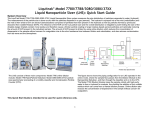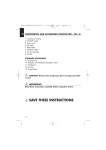Download BANG - INTRODUCTION
Transcript
Sparging Liquid Aerosol Generator (SLAG) Operation and Maintenance User’s Manual 1 1. Introduction The Sparging Liquid Aerosol Generator (SLAG) is a liquid nebulizer specially designed for the aerosolization at a low air pressure of sensitive and delicate microorganisms from aqueous solutions. The unique design of the SLAG minimizes the physical damage caused to the microorganisms during the aerosolization process, delivering close to 100% viable bioaerosols. A fluid metering pump is used to regulate the liquid flow rate. The standard SLAG model operates between 2 to 6 liters per minute depending upon the input air pressure. For higher bioaerosol outputs, a pressurized model with Stainless Steel jar is available. The concentration of the delivered bioaerosol can be controlled by adding dilution air. 2. Principle of Operation Unlike most of the other liquid nebulizers, SLAG does not use sheering and impaction processes to nebulize the test article. Instead, tiny droplets containing live microorganisms (their number depend on the solute concentration) are created by gently bursting bubbles of liquid. Knowledge of this aerosol formation mechanism is important in determining the aerosol characteristics as well as for proper operation of the nebulizer. The part that plays the key role in the nebulizing process is the air diffuser (Fig 1) Figure 1. Air diffuser 2 The air diffuser’s fritted plate is made of porous Stainless Steel, with nominal pore sizes 0.5 m or 2 m. The selection of the type of plate, i.e. pore size, will depend on the specific application (air flow rate and type of microorganism). The liquid bacterial solution is dispensed through a capillary at the center of the air diffusor where it spreads creating a thin layer of liquid on the surface. The bottom surface of the diffusor is pressurized with clean, dry air which penetrates the diffusor disc and is released from the pores on the top surface. This crates tiny air bubbles that burst at the surface of the liquid layer generating small droplets of liquid aerosol. Schematic of the aerosolization method employed by the SLAG and its complete setup are shown in Figures 2 and 3. The output of the generator is a function of the air diffusor size, air pressure and the feed rate of the liquid bacterial solution. SLAG models with 0.75”, 1.00” and 3.00” diameter air diffusors are available. Figure 2. Schematic of SLAG’s method 3 Figure 3. Typical SLAGs Setup with a CH Technologies Nose-Only Inhalation System 4 3. Working with the SLAG 3.1. Unpacking the SLAG When you receive your BANG, you should unpack it carefully and check to make certain that the following parts are all present in undamaged condition: 1 - The SLAG itself 2 - Single-channel peristaltic pump 3 - Tubing kit for peristaltic pump 4 – Spare parts kit (O-rings, fittings) 5 – Optional connector(s) for SLAGs outlet 6 – Optional spare diffusor disc(s) The appearance of your SLAG may vary slightly depending upon the specific model that you have ordered. The 0.75” and 1.00” SLAG models (Figure 4) have the same appearance; they only difference is the size of the diffusor disc. In contrast, the 3.00” model (Figure 5) has a larger body and air inlet from the bottom instead of from the top in the other models. Also, the type of fittings the SLAG is supplied with and the connector for the outlet may vary depending on the application. If you find that anything has been damaged in transit, contact the carrier of the shipment immediately in addition to CH Technologies. Figure 4. View of 0.75”/1.00” SLAG Figure 5. View of 3.00” SLAG 5 3.2. Assembling your SLAG 1. Your SLAG will arrive fully assembled, including the jar. Inspect all the parts visually and make sure that there are no damages to the metal parts or the jar. 2. Make sure that the jar is not connected loosely. If that’s the case, tighten it by hand ! ATTENTION! Do not screw the jar in too tightly or it will damage the Oring on the inside of the SLAG which may result in a loss of the seal 3. Place the SLAG on a clean, flat surface 4. If the fitting were shipped separately, connect the appropriate fittings to the air and liquid inlets of the device. Fittings for your specific application are provided. 5. Place a ring stand in the proximity of the SLAG 6. Using the provided holding bracket, assemble the peristaltic pump to the ring stand at an appropriate height and plug it to an appropriate power outlet 7. Following procedures outlined in peristaltic pump user’s manual, connect the provided silicone tubing to the pump’s head 8. Place a small vessel with the bacterial solution to be aerosolized close to the peristaltic pump 9. Insert on end of the silicone tubing into the bacterial solution 10. Connect the other end of the silicone tubing to the barb fitting of the SLAGs liquid feed inlet 11. Set the direction of the pump’s head rotation to match the direction of the liquid flow 12. Using the provided fittings, connect the compressed air line to the air inlet of the SLAG ! ATTENTION! In order to control SLAGs air supply, the compressed air line needs to be connected upstream to devices that control air pressure and flow rate as shown in Figure 3. Contact CH Technologies for appropriate air supply control instrumentation. 13. Last, using the optional connector provided by CH Technologies or by the end user, connect the SLAG outlet to the downstream application (i.e. exposure chamber, dynamic chamber, etc.) 6 3.3. Operating your SLAG 1. Using the air pressure and flow control instruments upstream of the SLAG, set the desired air pressure and flow rate. Generally, higher air flow rate should be used when higher aerosol output is required. However, be aware that air flow rate will affect the size of the droplets being generated. 2. Program the peristaltic pump to provide the desired liquid flow rate. The optimal liquid flow rate should be such that there is all the time a thin layer of liquid on the diffusor disc surface. 3. Release the nut of the liquid feed capillary, adjust the height so that the end of it is just a few millimeters from the surface of the disc and lock it in place. ! ATTENTION! Tighten the nut by hand, DO NOT use tools! 4. Turn ON air supply to the SLAG 5. In quick sequence, turn ON operation of the peristaltic pump 6. During operation, make sure that the air supply is constant and the test article vessel has enough bacterial solution to last for the whole work session 7. To stop aerosol generation, simply turn OFF air supply to the SLAG. At the same time, stop operation of the peristaltic pump 4. Cleaning and Maintenance Your SLAG should perform indefinitely if it is cleaned and maintained properly. The only change that may be necessary is replacement of the O-rings. After each use, drain the runoff solution that has collected in the SLAG jar. Then rinse the SLAG metal parts and the jar with distilled water and air dry by blowing air through them. All SLAG parts are manufactured of chemically and thermally resistant materials. Therefore, if required by your standard operation and safety procedures, the SLAG may be decontaminated with appropriate chemical disinfectants or may be autoclaved. It is recommended to thoroughly check the SLAG parts after each use. Little wear and tear is generally expected. However the rubber O-rings may wear out eventually. We have provided extra O-rings if you need to replace them. These should be checked first if there is any problem with aerosol production. Damaged O-rings will result in faulty 7 operation of the device. The location of the O-ring and all other parts is shown in Figure 6. Figure 6. Parts List of the SLAG The pores of the diffusor disc may get progressively clogged as a result of deposition of solids in the bacterial solution. This will result in decrease of aerosol output. Therefore, it is strongly recommended that the disc be periodically cleaned in an ultrasonic bath. To remove the diffusor disc from its housing simply unscrew the nut that holds in in place and remove the disc with a pair of tweezers. Place the disc in an ultrasonic bath and sonicate it for about 30 minutes. When done, rinse it with distilled water, dry it and place it back in the housing. Tighten the nut by hands. Store your SLAG only after it has been cleaned and dried. It is advisable to store it with the accessory package and instructions. 8 5. Warranty CH Technologies, Inc. certifies that each SLAG has been thoroughly tested and inspected before shipment. Each SLAG is warranted against defects in materials and workmanship for a period of 1 year after purchase. This requires that the user has complied with the above instructions on use, cleaning and maintenance. Contact CH Technologies for further advice and assistance if your BANG is not functioning properly. 6. Ordering Information To order spare parts or service your device, please, contact CH Technologies at: CH Technologies (USA), Inc. 263 Center Avenue Westwood, NJ 07675, USA Tel: +1 201 666 2335 Fax: +1 201 666 8119 Email: [email protected] 9









